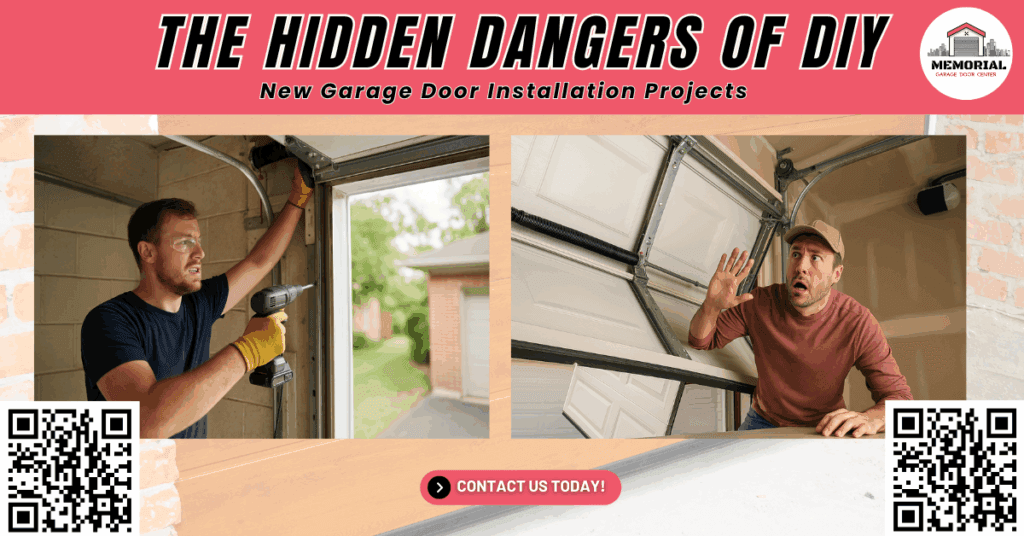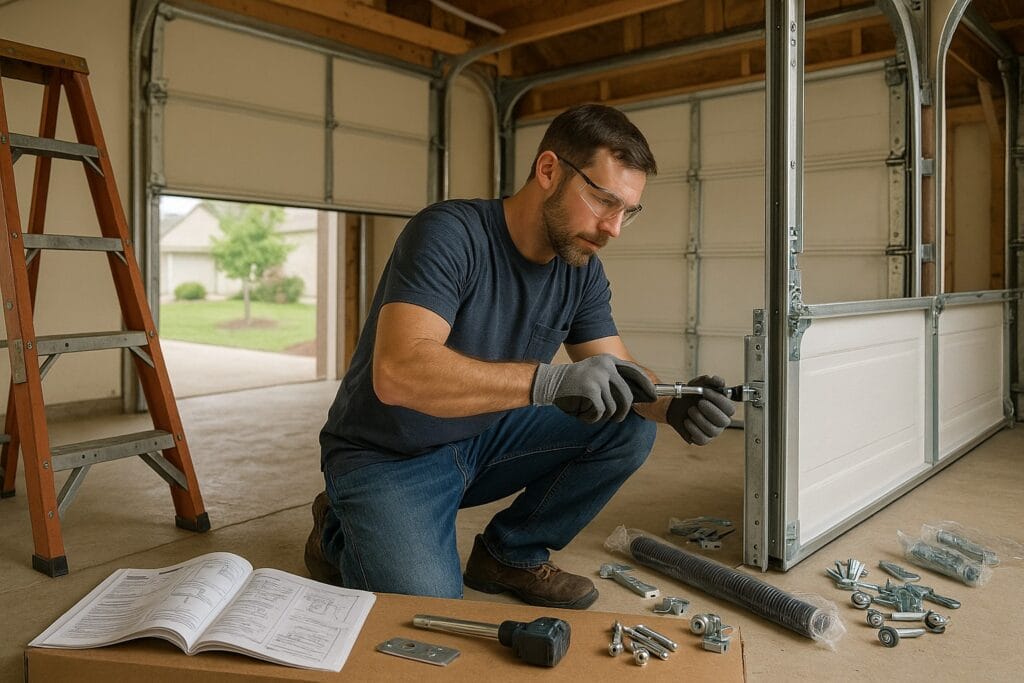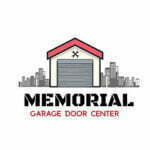The Hidden Dangers of DIY New Garage Door Installation Projects

In Houston, a homeowner named Mark decided to install a new garage door on his own, hoping to save a little bit of money and avoid scheduling a service team. However, during the installation process, one of the tightly wound torsion springs came loose, sending the garage door crashing to the ground. The bottom panel bent, the door frame cracked, and the garage door opener wiring shorted out. What started as a DIY project turned into an expensive emergency repair. Unfortunately, this situation is more common than most homeowners realize.
According to the U.S. Consumer Product Safety Commission, garage doors cause more than 20,000 injuries in the U.S. every year. A significant portion of these injuries occur during amateur installations or when performing garage door maintenance without proper tools and knowledge. Garage doors may seem simple, but they are complex systems composed of multiple hardware components that must be aligned perfectly for safe operation.
At Memorial Garage Door Center, located at 1312 Utah St, Houston, TX 77007, we specialize in professional garage door installation, repair, and maintenance services. We understand the temptation to save on labor costs, but it’s essential to understand the risks involved in attempting a new garage door installation without the right experience. Below is a comprehensive guide highlighting the hidden dangers of DIY installation and why relying on professionals is crucial for safety, energy efficiency, and long-term performance.
Why Homeowners Attempt DIY Garage Door Installation
Homeowners often embark on DIY garage door installation projects with good intentions. Some of the common motivations include reducing overall costs, personal satisfaction from completing a project, or a perceived sense of urgency when the old door becomes inoperable. While these reasons are understandable, they overlook the complexity of the garage door installation process.
Many DIY enthusiasts are drawn to instructional videos online or influenced by step-by-step installation guides that make the process appear easier than it is. These resources often omit critical safety precautions, or they assume access to specialized tools and a second set of hands. Garage doors require precision, patience, and strength to install properly. Failing to recognize the weight, balance, and engineering involved in the installation can lead to critical mistakes that jeopardize the functionality and safety of your garage door.
A new garage door installation involves more than lifting and mounting panels. It includes choosing the right garage door type, accounting for energy efficiency through insulation materials, aligning tracks and springs, installing the garage door opener, adjusting safety sensors, and calibrating hardware for smooth operation. Each step is part of a larger system, and skipping or mishandling even one component can compromise the entire door.

Moreover, many homeowners underestimate the labor required to complete such a project. It can take a professional installation team between 4 to 6 hours to install a standard garage door. For an amateur installer, the same task may stretch over multiple days due to a lack of specialized tools, limited knowledge of spring tension, and challenges aligning tracks and panels. This delay can lead to extended periods without a functioning garage door, compromising home security and daily convenience.
1. The Weight and Tension Are Extremely Dangerous
Garage doors are heavy. Depending on the door size, materials, and whether it is insulated or not, a garage door can weigh between 130 to 400 pounds. Steel doors, especially those with polyurethane or polystyrene insulation for energy efficiency, tend to weigh more than uninsulated models. When you attempt a DIY door installation, managing this weight without the proper lifting tools or support structures is risky.
Even more hazardous are the torsion and extension springs that counterbalance the garage door. These springs are under extreme tension and are critical for the smooth operation of the door. If a torsion spring is improperly wound or released accidentally, it can whip around with enough force to cause broken bones, deep lacerations, or even fatal injuries. DIY installers often lack the appropriate winding bars and safety tools required to manage spring tension safely.
Springs are not the only dangerous component. Garage door cables, drums, and tracks must all be properly installed and tensioned. Misjudging the balance can cause the door to slam shut or suddenly rise uncontrollably, leading to injury or property damage. Professional garage door technicians use precision tools to measure and adjust the tension for safe, smooth operation.
The installation process also involves aligning the drive carriage and screw drive carriage systems in garage door openers, which, if misaligned, can cause the opener motor to overwork or burn out. The risks here are not just physical but also involve damage to property and increased repair costs.
2. Improper Installation Damages Garage Door Systems
Garage doors rely on a network of interconnected components: tracks, brackets, rollers, springs, door panels, garage door openers, and safety sensors. A mistake during the installation process can lead to operational issues that may not be apparent immediately but develop over time. Misaligned tracks can cause the door to tilt or jam during operation. Loose or missing hardware can weaken the entire door structure, affecting the door frame and bottom panel alignment.
Even small errors, like using the wrong fasteners or over-tightening bolts, can compromise the stability of the garage door. Misjudging the spacing between panels or improperly setting the opener’s travel limits may result in noisy operation, uneven wear, or repeated breakdowns. Long-term, these issues reduce the lifespan of your garage door and its components.
Incorrectly installed garage door openers often fail to engage properly with the door, resulting in delayed responses, noisy operation, or complete failure. For smart garage door openers that support remote access and mobile app integration, DIY errors can interfere with connectivity and compromise security.
Another common issue involves failing to properly install safety sensors or adjust final settings on the opener. This can cause the auto-reverse feature to malfunction, putting family members, pets, or belongings at risk. Over time, these errors contribute to increased energy consumption, additional maintenance, and early system failures.
3. Lack of Safety Features Puts Families at Risk
Garage doors come equipped with several safety features intended to protect users and property. These include photo-eye safety sensors that detect motion or obstructions, auto-reverse mechanisms that prevent the door from closing on objects, manual emergency release systems, and alert notifications for smart openers. When a garage door installation is done improperly, these features may not function as intended.
Failing to test or calibrate these safety systems can be catastrophic. A malfunctioning sensor may not detect a child’s toy, a bicycle, or even a person standing in the door’s path. The garage door could close with full force, causing injury or damage. This is particularly important in homes with young children or elderly residents who may not be able to react quickly.
DIY installers may overlook wiring connections, sensor alignment, or the calibration of the garage door opener. This can lead to situations where the garage door closes on bicycles, packages, or worse, people or pets. Moreover, failing to install or test the manual release properly can leave the door unusable during power outages, removing critical access to your home.
Professionally installed doors undergo a series of safety checks, including balance testing, limit switch adjustments, sensor calibration, and control panel programming. Skipping these steps leaves your home vulnerable and can result in serious accidents or security breaches.
4. Electrical Hazards and Smart Openers
Today’s garage doors increasingly rely on smart technology and advanced features, including backup battery systems, Wi-Fi connectivity, integrated lighting, and keyless entry systems. Installing these components incorrectly can introduce serious electrical hazards, including electrical shock, circuit shorts, or damage to the logic board of the garage door opener.
DIY installers often lack the electrical expertise to safely wire these systems into the home’s power supply. Issues like improperly grounded outlets, incorrect voltage, or incompatible components can result in dangerous conditions. In some cases, homeowners damage the opener’s motherboard by connecting it to incompatible surge protectors or by failing to account for local voltage standards.
Moreover, many smart openers require firmware updates and mobile app configurations to function correctly. Setting up secure remote access involves configuring encryption, Wi-Fi routers, and device pairing. Mistakes in this process can leave your home’s garage system vulnerable to hacking or lockout issues.
Additionally, smart openers require precise setup procedures to integrate with mobile apps and home networks. Incorrect setup leads to poor Wi-Fi signals, lagging operation, or failed remote access, defeating the purpose of these advanced features.
5. Voided Warranties and Code Violations
One of the hidden costs of DIY garage door installation is the potential to void manufacturer warranties. Most reputable brands, including those like Stanley garage doors, clearly state that warranties are only valid when installed by certified professionals. If something goes wrong later, whether due to a faulty part or improper installation, you may be left to cover the repair or replacement costs entirely.
Furthermore, improperly installed garage doors may violate local building codes or homeowner association guidelines. In Houston and surrounding areas, garage doors must meet specific standards for wind load, insulation value (R-value), and safety systems. DIY installations that don’t comply with these standards can result in failed inspections, fines, and legal liability if an accident occurs.
Insurance claims related to damage or injury caused by an improperly installed door may also be denied. This exposes homeowners to significant financial risk and legal complications. A certified installer ensures compliance with all local regulations, preserves your warranty coverage, and protects the value of your home by providing documentation for future resale or insurance purposes.
6. Costly Mistakes That Cancel Out Savings
The primary reason homeowners attempt DIY installations is to save on labor costs. However, this often backfires. Here are common errors and their financial consequences:
Mistake | Consequence | Estimated Cost |
Misaligned track | Door binds or derails | $250 – $450 |
Broken spring | Emergency replacement | $300 – $600 |
Damaged opener | Replace entire unit | $350 – $650 |
Bent panel | New panel or full door replacement | $1,000+ |
Electrical damage | Replace opener motherboard | $250 – $500 |
In most cases, the cost of correcting mistakes outweighs what you would pay for professional garage door installation. Factor in lost time, stress, and potential injury, and the DIY route becomes less appealing.
Worse, if these errors lead to property damage or injury, the overall cost can multiply exponentially, impacting your budget, insurance rates, and peace of mind.
7. Physical Strain and Personal Injury
Installing a garage door is a labor-intensive project that involves lifting heavy door panels, holding components in place while securing hardware, climbing ladders, and making repeated adjustments. Without assistance and proper lifting equipment, this work can lead to:
- Back strains from lifting heavy panels
- Shoulder or wrist injuries from overuse
- Cuts from sharp metal edges
- Ladder-related falls
Crushed fingers from dropped parts or shifting panels

The risk of injury increases if you’re working alone or without proper training. Using the wrong tools, like pliers instead of winding bars, further amplifies the danger. Professional garage door installers are trained to recognize risks and use preventative measures.
Professionals use specialized tools like panel lifters, power drills with torque control, safety harnesses, and garage door jacks to avoid injury. Most importantly, they work in coordinated teams to share the workload safely and efficiently.
8. Time Drain and Frustration
DIY garage door installation projects often take far more time than expected. What seems like a weekend task can turn into a multi-day ordeal due to missing hardware, difficult-to-follow manuals, improper measurements, or the need to undo mistakes. The steps involved, such as aligning door tracks, securing torsion springs, adjusting opener settings, and testing safety features, require both skill and patience.
This time drain becomes even more frustrating when the garage is your primary point of entry to your home or when you’re trying to meet a deadline. In contrast, a professional installation team can complete the entire process, from uninstalling your old garage door to final adjustments on your new door, in just a few hours.
Delays also increase vulnerability to weather, pests, and theft if your garage is left unsecured overnight. For many homeowners, the frustration alone makes DIY installation an impractical option.
9. When DIY Makes Sense And When It Doesn’t
There are minor garage door tasks that homeowners can safely manage themselves, including:
- Cleaning garage door tracks
- Lubricating moving parts like rollers and hinges
- Replacing weather stripping
- Testing garage door sensors
However, installing a new garage door is not one of them. This is a job best left to trained professionals with experience, tools, and the knowledge required to ensure proper, safe operation. Attempting it yourself could lead to a project that costs more, takes longer, and results in poorer performance than if you had hired a certified installer from the start.
When it comes to garage door installation, think of it as an investment. You’re not just paying for a new door; you’re ensuring security, energy efficiency, and long-term performance for your home.
How Can Memorial Garage Door Center Help You?
At Memorial Garage Door Center, we understand how important your garage is to your home’s security, energy efficiency, and curb appeal. That’s why we provide professional, dependable, and affordable garage door services throughout Houston and the surrounding areas. Whether you’re replacing an old garage door or building a new home that needs the right garage door for your lifestyle, our expert team is here to help.
Here’s what you can expect from us:
- Custom Garage Door Installation: We work with all types of garage doors, including insulated steel doors, roll-up doors, smart openers, and stylish options with decorative hardware to match your home’s design.
- Certified Technicians: Our installation team is fully trained and equipped to handle everything from track alignment to final adjustments on your garage door opener.
- Warranty Protection: We ensure your installation meets all manufacturer specifications to maintain full warranty coverage.
- Emergency Repairs: Have an issue with your garage door or opener? Call us for prompt service and expert diagnosis.
- Energy-Efficient Solutions: We offer insulated garage doors with high R-values to reduce your energy consumption and conserve energy throughout the year.
- Comprehensive Consultations: We help you choose the right garage door style, material, insulation level, and safety features based on your home’s needs and budget.
Let us make your next garage door project smooth, safe, and successful.
Memorial Garage Door Center
1312 Utah St, Houston, TX 77007
Call Today: (281) 720-3113
Don’t risk your safety or your investment on a DIY installation. Trust the local experts who get the job done right, the first time.
Frequently Asked Questions (FAQs)
1. Can I reuse the tracks and opener from my old garage door for a new installation?
In most cases, it’s not recommended; new doors are designed with specific hardware, and using old tracks or openers can cause misalignment or unsafe operation.
2. What permits or inspections are required for garage door installation in Houston?
Depending on your neighborhood and HOA, you may need a city permit and final inspection to ensure compliance with wind load and building codes.
3. How long does a professionally installed garage door typically last?
With proper maintenance, a professionally installed garage door can last 15 to 30 years, depending on material, usage, and climate.
4. What’s the difference between torsion springs and extension springs?
Torsion springs are mounted above the door and offer smoother, more controlled movement, while extension springs stretch along the sides and are more prone to wear and imbalance.
